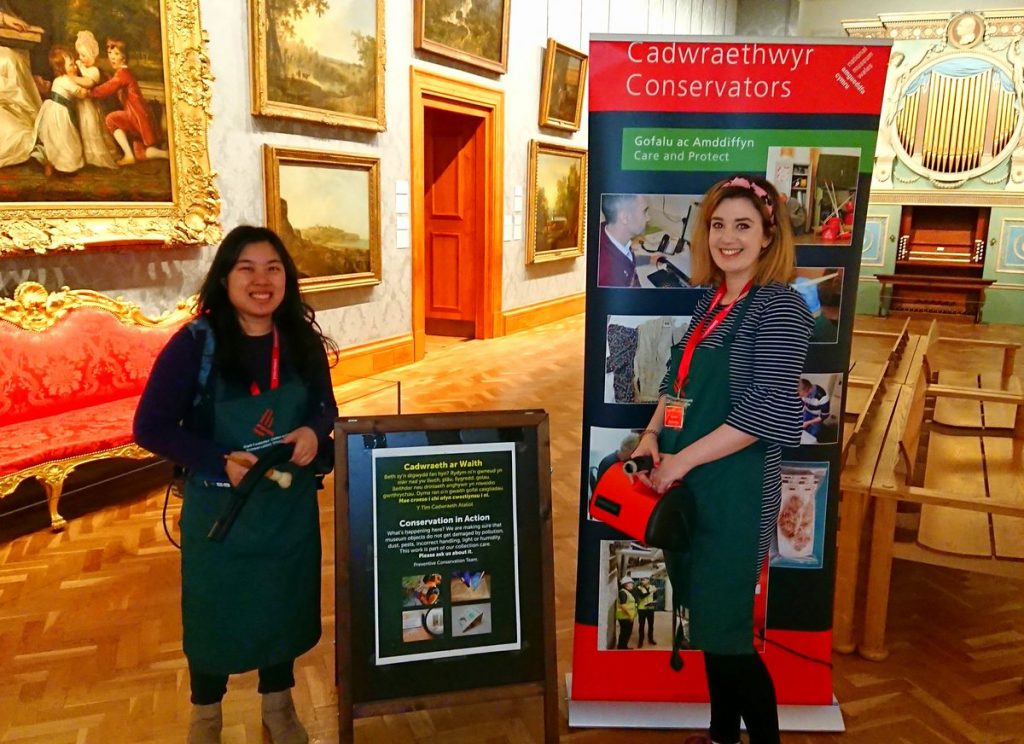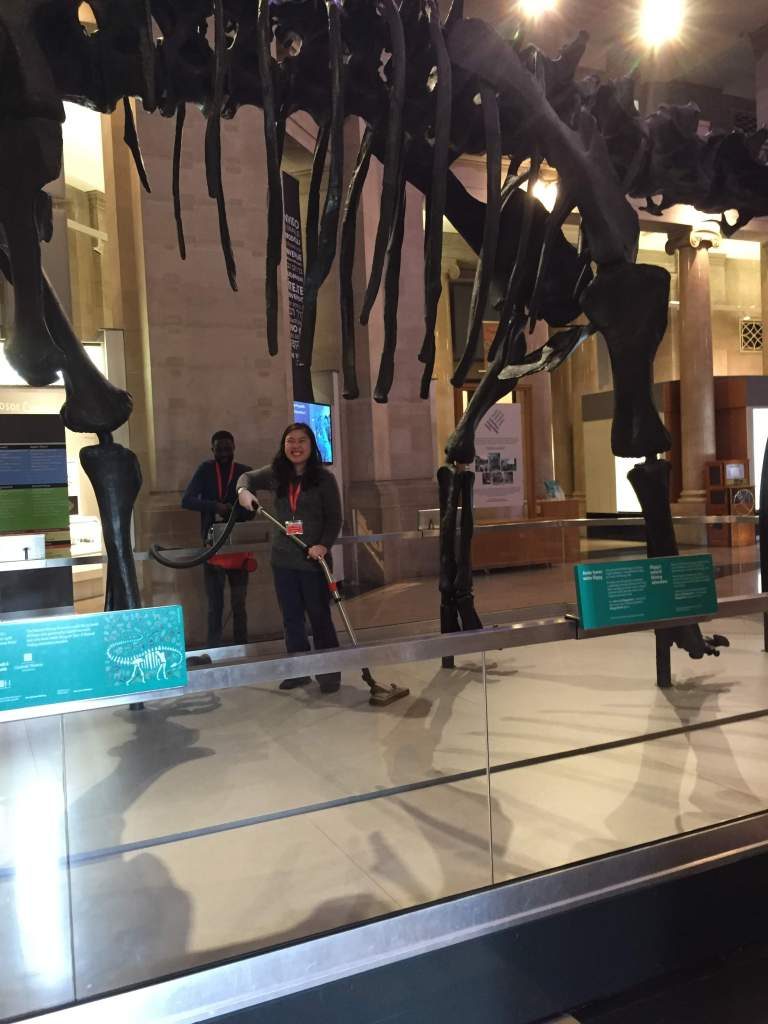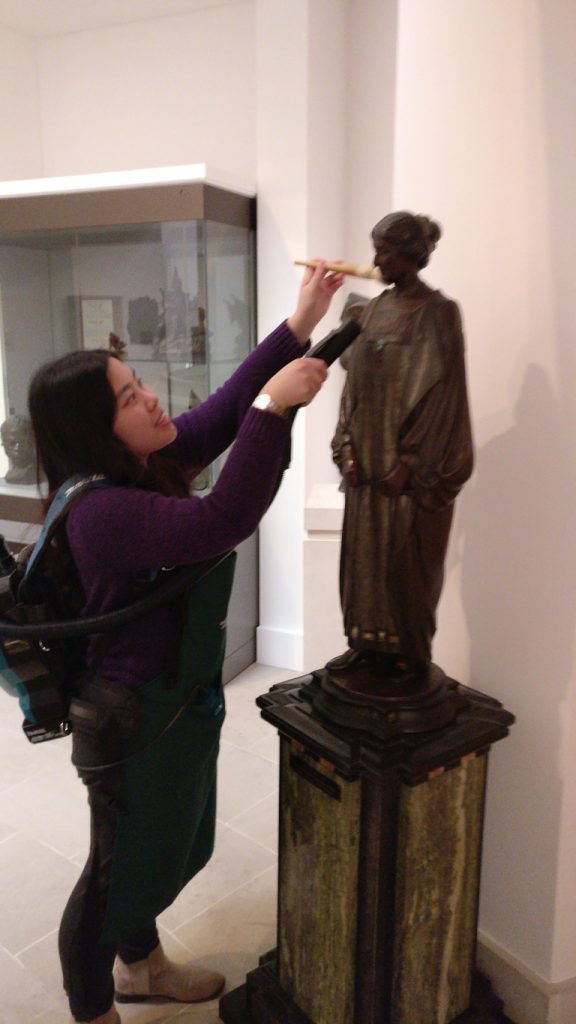Volunteering at National Museum Wales (Preventive conservation)
27 May 2020Hello! Before I begin talking about my time volunteering, I should do a short introduction about myself. I’m a MSc Care of Collections student at Cardiff University. It’s a one year masters program where you learn about how to do preventive conservation. What is preventive conservation, you may ask? Don’t worry, I only really understood what it was halfway through the course so we’re good. It’s the actions that we take to prevent museum objects from deteriorating quickly. We can’t stop deterioration, but we can sure try to slow it down. We take actions so that (cross our fingers real tight) we don’t have to send them off to a conservator to work on….at least not in the near future, probably in 100 years or so but not while I’m alive, baby. I know there seems to be a lot of stuff added on to my description of what preventive conservation is, but that’s because there’s a whole lot of debate about those issues so I’m trying to be as clear as I can but not go into too much detail, you know?
Anyways, so that’s what I learn and so this volunteering is specifically for preventive conservation – because there are other volunteering opportunities available at the museum like conservation, interacting with visitors, cataloguing, gardening, etc. I want to be as specific as I can to help whomever in the future is interested in volunteering for this.
So, let’s jump right into it. The main thing that I did as a volunteer was integrated pest management (IPM). Now don’t worry, it doesn’t involve catching any insects (although you may need to pick up pest monitors filled with insects). It’s really about monitoring pests by laying monitors and checking them in this case every 6 months to see what sort of pests we’ve caught. This will allow us to determine what sort of pests we’re dealing with and where, so that we can take action. Pests are a problem because they (especially the larvae) find museum objects especially delicious. National Museum Wales has a natural history collection, so dead animals and pests don’t go well together (especially if we don’t want our collections to be eaten and destroyed).
The part I found easy was the one where you looked at a floorplan with the pest monitors marked on it and located the monitor. The not so easy part was the identification of insects. We identify the insects caught in the trap and write down the type and approximate number on the back of the monitor. It took a while and I made my own cheat sheet to help, but really after a while you’ll see that the same pests come up again and again so it’s a matter of learning how to identify them by certain distinct features. We would also change pest monitors once they were filled with insects.
Two interesting things I learned from this is that spiders are not considered pests because they don’t eat the collection, but they are a sign that there are insects that we should worry about because the spiders eat those insects. Secondly is that sometimes when the pest monitor is not too full, we leave the monitor there again, even if it has one or two dead insects. The next time we go and check it we can see what changes there are (since we mark what type of pests are caught on the monitors) and sometimes we find things have changed after some months. For example, if there was a larvae and an adult insect, and 6 months later we find only the larvae shell, what do you think happened? Basically the larvae hatched and the sticky parts of the monitor wasn’t sticky anymore from the dust trapped on it, so the larvae found some convenient food – another insect – ate it, grew and went away. Not everybody finds that fascinating, but I thought that was cool when I learned about it. Other IPM-related things we learned was to identify frass. Frass is insect droppings. Being able to identify them will enable you to learn if you have a pest infestation.
Moving on, another thing we did was dusting and interacting with visitors. Why do these go together? Usually we dust in the galleries and it’s a fantastic opportunity to talk to visitors about what we’re doing and why. As you can see from the picture here, I’m wearing a backpack vacuum holding a brush and my fellow volunteer has a small vacuum too. We usually set up like this with the poster and sandwich board, just so that if visitors are shy they can read about what we’re doing on their own. In the background you can see some pictures and the organ (we’re in the gallery with the organ and had just finished dusting the frames). Dust comprises dead human skin and some organic material from clothes and other objects that enter the galleries, so they can accumulate on frames, especially those around the height of the average person. We vacuum because dust can cause damage on the frames and doesn’t make them look very nice – and dust is also food for pests.

One of the most amazing experiences I had whilst volunteering was being able to vacuum under Dippy the dinosaur! Dippy is a replica dinosaur skeleton from the Natural History Museum and currently (2018-2020) he’s on tour around the UK. National Museum Wales Cardiff hosted Dippy from November till end of January and he brought in a lot of people. Lots of people means lots of accumulated dust, so I helped to vacuum it all and keep Dippy clean and happy. I think it’s really fun, because how many people can say they cleaned up in a dinosaur enclosure? I had to be really careful of course and not bump into any of his bones, especially the feet. As you can see, I’m the perfect height as I’m short enough to not bump into the bones making up the body section.

We were taught techniques for dusting objects and it’s really about the magic wand swish and putting the nozzle of the vacuum at an angle to catch the dust.

Lastly we did microclimate conditioning. We worked with the archaeology collection for this. They were kept in Stewart boxes and we needed to change the silica gel so that the microclimate in each box was dry enough to prevent corrosion from happening to the metal archaeological objects. We also put a humidity indicator to see if the silica gel was doing its job. Metals need to be kept in conditions with low humidity to prevent corrosion from happening, so the silica gel functions to absorb the moisture that is trapped in the box and the moisture that seeps into the box after a while. It was fun seeing all the cool archaeological finds, especially the helmet collection.
Another thing that I really loved was the diversity of the volunteer team. I’m from Malaysia and my fellow volunteers came from Ireland, Scotland and Senegal. It’s really good that we all had this chance to gain experience, learn and get to know each other through volunteering. Background wise, 3/4 of us were Care of Collections and Conservation students at Cardiff University, while one was volunteering time doing media shoots. So you don’t need to be in conservation to do this, you just need to have the interest and passion to learn.
I hope this has given some helpful insight to anyone who wants to learn more about volunteering at NMW or preventive conservation.
Please note that everything here is my own personal experience and opinions, everyone has a different volunteering experience. If you want to learn more check out the links below.
Here is the NMW preventive conservation twitter account if you want to check out some of the things I did and preventive conservation related topics. The official Amgueddfa Volunteers Twitter account is really useful to get more information too, and of course the Amgueddfa Caerdydd/National Museum Cardiff Twitter account.
Another previous volunteer (Cardiff alumni Will Tregaskes) has written about his experience doing the same volunteering program, so you might want to check out his post. Also check out the ‘Volunteer’ tag in the blog for other posts on volunteering experiences.
This blog post was originally written for and published at mylittlechateau.
- March 2024 (1)
- December 2023 (1)
- November 2023 (2)
- March 2023 (2)
- January 2023 (6)
- November 2022 (1)
- October 2022 (1)
- June 2022 (6)
- January 2022 (8)
- March 2021 (2)
- January 2021 (3)
- June 2020 (1)
- May 2020 (1)
- April 2020 (1)
- March 2020 (4)
- February 2020 (3)
- January 2020 (5)
- November 2019 (1)
- October 2019 (1)
- June 2019 (1)
- April 2019 (2)
- March 2019 (1)
- January 2019 (1)
- August 2018 (2)
- July 2018 (5)
- June 2018 (2)
- May 2018 (3)
- March 2018 (1)
- February 2018 (3)
- January 2018 (1)
- December 2017 (1)
- October 2017 (4)
- September 2017 (1)
- August 2017 (2)
- July 2017 (1)
- June 2017 (3)
- May 2017 (1)
- March 2017 (2)
- February 2017 (1)
- January 2017 (5)
- December 2016 (2)
- November 2016 (2)
- June 2016 (1)
- March 2016 (1)
- December 2015 (1)
- July 2014 (1)
- February 2014 (1)
- January 2014 (4)